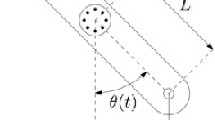Abstract
A two-dimensional random motion of a point is dealt with. The point velocity (v cos ϑ,v sin ϑ) is subjected to two different kinds of perturbations, the first represented by a vector of independent standard Wiener processes and the second by a generalized type of Poisson process. The control function is ϑ, whilev is kept fixed. We assume given a configuration ofn+1 target sets,A 0,...,A n , in the plane, all of these sets being surrounded by an open and bounded setD. We denote by ℙ x (ℙ(ϑ)∈A i the probability thatX t , the location of the point, whereX 0=x∈D, will reach the setA i beforeX i reaches any other setA j ,i≠j, and before it leavesD. The problem dealt with here is to find an optimal control law ϑ*, ϑ*=ϑ*(x),x∈D, such that the function
where λ1,i=0,...,n, are given nonnegative numbers, will be maximized on a given class of admissible control laws. Sufficient conditions on optimal controls, of a dynamic programming type, are derived. These conditions require the existence of a smooth solution to a nonlinear partial integrodifferential equation, which is solved here by applying a finite-difference scheme. Two examples are dealt with numerically.
Similar content being viewed by others
References
Gikman, I. I., andSkorohod, A. V.,Stochastic Differential Equations, Springer-Verlag, Berlin, Germany, 1972.
Katayama, T.,Optimal Bang-Bang Controls That Maximize the Probability of Hitting a Target Manifold, International Journal of Control, Vol. 15, pp. 737–750, 1972.
Greenspan, D.,Numerical Studies of Steady, Viscous, Incompressible Flow in a Channel with a Step, Journal of Engineering Mathematics, Vol. 3, pp. 21–28, 1969.
Friedman, M., andYavin, Y.,Computation of Optimal Controls for a Nonlinear Stochastic Third-Order System, Journal of Optimization Theory and Applications, Vol. 21, pp. 213–223, 1977.
Kushner, H. J., andDimasi, G.,Approximations for Functionals and Optimal Control Problems on Jump Diffusion Processes, Brown University, Providence, Rhode Island, Lefschetz Center for Dynamical Systems, Technical Report No. 76-2, 1976.
Kushner, H. J.,Probability Methods for Approximations in Stochastic Control and for Elliptic Equations, Academic Press, New York, New York, 1977.
Kushner, H. J., andYu, C. F.,Probability Methods for the Convergence of Finite Differences Approximations to Partial Differential-Integral Equations, Part 2, Journal of Mathematical Analysis and Applications, Vol. 45, pp. 54–72, 1974.
Author information
Authors and Affiliations
Additional information
Communicated by J. V. Breakwell
This work was partially supported by a grant from Control Data.
Rights and permissions
About this article
Cite this article
Yavin, Y., Jordaan, A.M. Optimal controls that maximize the probability of hitting a set of targets: A numerical study. J Optim Theory Appl 34, 517–540 (1981). https://doi.org/10.1007/BF00935891
Issue Date:
DOI: https://doi.org/10.1007/BF00935891




